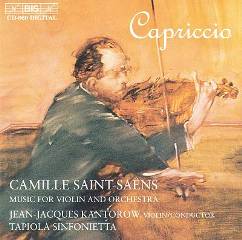Camille Saint-Saëns - Music for Violin and Orchestra (1998)
Camille Saint-Saëns - Music for Violin and Orchestra (1998)

Concerto for Violin and Orchestra No. 1 in A Major, Op. 20 1. I. Allegro 00:04:11 2. II. Andante espressivo 00:01:44 3. III. Tempo I 00:04:45 4. Introduction et rondo capriccioso in A Minor, Op. 28 00:08:42 5. Romance in C Major, Op. 48 00:06:12 6. Havanaise in E Major, Op. 83 00:08:25 7. Sarabande No. 1, Op. 93 00:05:43 8. Morceau de concert in G Major, Op. 62 00:09:23 Jean-Jacques Kantorow - violin Tapiola Sinfonietta Jean-Jacques Kantorow - conductor
Camille Saint-Saëns' Violin Concerto No. 1 in A major, Op. 20, was often referred to by his contemporaries as a Konzertstück, the then-current term for a one-movement concerto, even though the composer wrote it as three distinct movements. It's easy to understand the confusion, though; the concerto is actually written in large-scale ternary form, with an Andante espressivo middle movement enclosed by an opening Allegro and what is called its reprise. However, that schematic layout doesn't quite capture Saint-Saëns' invention, which continually reuses, reorganizes, and recasts material over the concerto's quarter-hour span to create a dense, lively texture of ideas. Op. 20 must have proved a splendid concertante vehicle for Pablo de Sarasate, its dedicatee, who was only 15 at the time. The violin introduces the idea that will dominate the discourse; a few bold, choppy chords followed by a precipitous rise and descent. After the orchestra takes up the idea, the violins re-enters with a sinuous, suave derivative of the opening that it develops over shifting orchestral textures, before introducing another subject, in the minor mode. This subject, songful and hushed, contains a descent and rise which register as an opposition to the opposite movement in the opening subject. That opening subject returns to dominate the rest of the movement, which ends on more suave violin soloing that trills directly into the Andante. This Andante uses a reticent woodwind figure, derived from the opening subject's chords, to frame a leisurely violin melody that references both the opening subject and the minor subject of the previous movement. The third movement's title of "reprise" must be one of the bigger understatements in nineteenth century music; while the same material is developed, the development takes radically different turns, including a surprisingly peaceful moment in which the opening subject's chords, quiet and unadorned, move from section to section of the orchestra, pushed by sweet sustained notes on the violin. The interplay of subjects and derivatives thereof pushes the music onward with both wit and vigor throughout. --- Andrew Lindemann Malone, Rovi
download: uploaded yandex 4shared mediafire solidfiles mega zalivalka filecloudio anonfiles oboom ziddu
Zmieniony (Wtorek, 22 Kwiecień 2014 11:28)








